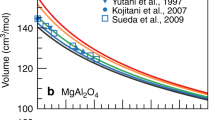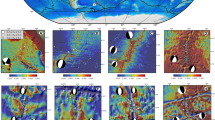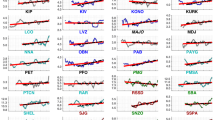Abstract
Understanding accretion and deformation processes at mid-ocean ridges is crucial as they control the resulting oceanic crustal structure, which covers two-thirds of Earth’s surface. The most common tool for observing such dynamic processes within the Earth is seismic anisotropy. Iceland, which is uplifted by a convective mantle plume and has an active spreading ridge system exposed above sea level, offers a unique opportunity for studying this phenomenon. Here we use a high-resolution dataset of Love and Rayleigh wave speeds to constrain the seismic anisotropy in the Icelandic crust. We show that seismic anisotropy in the lower crust is controlled by crystal preferred orientation, providing a direct observation of lower crustal flow. Furthermore, since shear is needed to align the crystals, our results reveal that crustal flow cannot be a simple translation of mass and requires internal deformation. This finding suggests that crustal flow plays an important role in oceanic crustal accretion and deformation where thick, hot oceanic crust is formed, such as at volcanic rifted margins and where there are mantle plume–ridge interactions.
This is a preview of subscription content, access via your institution
Access options
Access Nature and 54 other Nature Portfolio journals
Get Nature+, our best-value online-access subscription
$29.99 / 30 days
cancel any time
Subscribe to this journal
Receive 12 print issues and online access
$259.00 per year
only $21.58 per issue
Buy this article
- Purchase on Springer Link
- Instant access to full article PDF
Prices may be subject to local taxes which are calculated during checkout




Similar content being viewed by others
Data availability
Seismic data from the HOTSPOT (https://doi.org/10.7914/SN/XD_1996) network, the Cambridge University network in Iceland (https://doi.org/10.7914/SN/Z7_2010) and the station BORG from the GSN network (https://doi.org/10.7914/SN/II) can be freely accessed on the Incorporated Research Institutions for Seismology website (http://service.iris.edu/fdsnws/dataselect/1/). Data from the IMAGE project by GFZ (stations KEF, SUH, HOV) and from BGS (stations FAL1, FAL 3) are available from those institutions and were used under license for the current study: for data requests from GFZ or BGS, please contact those organizations directly. All seismic noise cross correlations used in this work are freely available at https://doi.org/10.6084/m9.figshare.13228211.
Code availability
All software used in this work is freely available online. MSNoise, a Python package for computing cross correlations, is available at http://www.msnoise.org/. ts-PWS, a software package for computing the time-scale phase-weighted stack, is available at https://github.com/sergiventosa/ts-PWS. SURF96, software for surface wave analysis, is available at http://www.eas.slu.edu/eqc/eqc_cps/.
References
Duennebier, F. K. & Sutton, G. H. Fidelity of ocean bottom seismic observations. Mar. Geophys. Res. 17, 535–555 (1995).
Mangano, G., D’Alessandro, A. & D’Anna, G. Long term underwater monitoring of seismic areas: design of an ocean bottom seismometer with hydrophone and its performance evaluation. In Proc. Oceans 2011 IEEE (Santander, 2011); https://doi.org/10.1109/Oceans-Spain.2011.6003609
White, R. & McKenzie, D. Magmatism at rift zones: the generation of volcanic continental margins and flood basalts. J. Geophys. Res. https://doi.org/10.1029/JB094iB06p07685 (1989).
Darbyshire, F. A., Bjarnason, I. T., White, R. S. & Flóvenz, Ó. G. Crustal structure above the Iceland mantle plume imaged by the ICEMELT refraction profile. Geophys. J. Int. https://doi.org/10.1046/j.1365-246X.1998.00701.x (1998).
White, R. S., McKenzie, D. & O’Nions, R. K. Oceanic crustal thickness from seismic measurements and rare earth element inversions. J. Geophys. Res. 97, 19683–19715 (1992).
Christeson, G. L., Goff, J. A. & Reece, R. S. Synthesis of oceanic crustal structure from two-dimensional seismic profiles. Rev. Geophys. https://doi.org/10.1029/2019RG000641 (2019).
Staples, R. K. et al. Färoe-Iceland Ridge Experiment 1. Crustal structure of northeastern Iceland. J. Geophys. Res. Solid Earth 102, 7849–7866 (1997).
Jenkins, J. et al. Crustal formation on a spreading ridge above a mantle plume: receiver function imaging of the Icelandic crust. J. Geophys. Res. Solid Earth 123, 5190–5208 (2018).
Allen, R. M. et al. Plume-driven plumbing and crustal formation in Iceland. J. Geophys. Res. 107, 2163 (2002).
Brandsdóttir, B., Menke, W., Einarsson, P., White, R. S. & Staples, R. K. Färoe-Iceland Ridge Experiment 2. Crustal structure of the Krafla central volcano. J. Geophys. Res. Solid Earth 102, 7867–7886 (1997).
Hardarson, B. S., Fitton, J. G., Ellam, R. M. & Pringle, M. S. Rift relocation—a geochemical and geochronological investigation of a palaeo-rift in northwest Iceland. Earth Planet. Sci. Lett. https://doi.org/10.1016/s0012-821x(97)00145-3 (1997).
Pálmason, G. Crustal Structure of Iceland from Explosion Seismology Publ. 40 (Soc. Sci. Islandica, 1971).
Gudmundsson, Ó. The dense root of the Iceland crust. Earth Planet. Sci. Lett. 206, 427–440 (2003).
DeMets, C., Gordon, R. G. & Argus, D. F. Geologically current plate motions. Geophys. J. Int. 181, 1–80 (2010).
Flóvenz, Ó. G. & Saemundsson, K. Heat flow and geothermal processes in Iceland. Tectonophysics 225, 123–138 (1993).
Hjartardóttir, Á. R., Einarsson, P. & Björgvinsdóttir, S. G. Fissure swarms and fracture systems within the Western Volcanic Zone, Iceland—effects of spreading rates. J. Struct. Geol. 91, 39–53 (2016).
Shapiro, N. M., Ritzwoller, M. H., Molnar, P. & Levin, V. Thinning and flow of Tibetan crust constrained by seismic anisotropy. Science 305, 233–236 (2004).
Duret, F. et al. Surface wave dispersion across Tibet: direct evidence for radial anisotropy in the crust. Geophys. Res. Lett. 37, L16306 (2010).
Li, A. & Detrick, R. S. Azimuthal anisotropy and phase velocity beneath Iceland: implication for plume–ridge interaction. Earth Planet. Sci. Lett. 214, 153–165 (2003).
Bjarnason, I. T., Silver, P. G., Rümpker, G. & Solomon, S. C. Shear wave splitting across the Iceland hot spot: results from the ICEMELT experiment. J. Geophys. Res. 107, 2382 (2002).
Bjarnason, I. T. & Schmeling, H. The lithosphere and asthenosphere of the Iceland hotspot from surface waves. Geophys. J. Int. 178, 394–418 (2009).
Bensen, G. D. et al. Processing seismic ambient noise data to obtain reliable broad-band surface wave dispersion measurements. Geophys. J. Int. 169, 1239–1260 (2007).
Yao, H., van der Hilst, R. D. & de Hoop, M. V. Surface-wave array tomography in SE Tibet from ambient seismic noise and two-station analysis—I. Phase velocity maps. Geophys. J. Int. 166, 732–744 (2006).
Herrmann, R. B. Computer programs in seismology: an evolving tool for instruction and research. Seismol. Res. Lett. 84, 1081–1088 (2013).
Anderson, D. L. Recent evidence concerning the structure and composition of the Earth’s mantle. Phys. Chem. Earth https://doi.org/10.1016/0079-1946(65)90013-3 (1965).
Dziewonski, A. M. & Anderson, D. L. Preliminary reference Earth model. Phys. Earth Planet. Inter. 25, 297–356 (1981).
Barclay, A. H. Shear wave splitting and crustal anisotropy at the Mid-Atlantic Ridge, 35° N. J. Geophys. Res. 108, 2378 (2003).
Dunn, R. A. & Toomey, D. R. Crack-induced seismic anisotropy in the oceanic crust across the East Pacific Rise (9° 30’ N). Earth Planet. Sci. Lett. 189, 9–17 (2001).
White, R. S. et al. Dynamics of dyke intrusion in the mid-crust of Iceland. Earth Planet. Sci. Lett. https://doi.org/10.1016/j.epsl.2011.02.038 (2011).
Sigmundsson, F. et al. Segmented lateral dyke growth in a rifting event at Bárðarbunga volcanic system, Iceland. Nature https://doi.org/10.1038/nature14111 (2014).
Backus, G. E. Long-wave elastic anisotropy produced by horizontal layering. J. Geophys. Res. 67, 4427–4440 (1962).
Jousselin, D., Morales, L. F. G., Nicolle, M. & Stephant, A. Gabbro layering induced by simple shear in the Oman ophiolite Moho transition zone. Earth Planet. Sci. Lett. 331–332, 55–66 (2012).
Russell, J. B. et al. High-resolution constraints on Pacific upper mantle petrofabric inferred from surface-wave anisotropy. J. Geophys. Res. Solid Earth https://doi.org/10.1029/2018JB016598 (2019).
Bastow, I. D., Pilidou, S., Kendall, J.-M. & Stuart, G. W. Melt-induced seismic anisotropy and magma assisted rifting in Ethiopia: evidence from surface waves. Geochem. Geophys. Geosyst. 11, Q0AB05 (2010).
Bacon, C. A., White, R. S. & Rawlinson, N. Depth Constraints on Seismic Anisotropy in Iceland from Shear Wave Splitting Measurements. In Proc. AGU Fall Meeting abstr. S41D-0559 (2019).
Blackman, D. K., Wenk, H.-R. & Kendall, J. M. Seismic anisotropy of the upper mantle 1. Factors that affect mineral texture and effective elastic properties. Geochem. Geophys. Geosyst. https://doi.org/10.1029/2001gc000248 (2002).
Blackman, D. K. & Kendall, J.-M. Seismic anisotropy in the upper mantle 2. Predictions for current plate boundary flow models. Geochem. Geophys. Geosyst. https://doi.org/10.1029/2001gc000247 (2002).
Long, M. D. & Becker, T. W. Mantle dynamics and seismic anisotropy. Earth Planet. Sci. Lett. 297, 341–354 (2010).
Becker, T. W. & Lebedev, S. Dynamics of the lithosphere and upper mantle in light of seismic anisotropy. Preprint at https://doi.org/10.31223/osf.io/kaznt (2019).
Ben Ismaïl, W. & Mainprice, D. An olivine fabric database: an overview of upper mantle fabrics and seismic anisotropy. Tectonophysics 296, 145–157 (1998).
Satsukawa, T. et al. A database of plagioclase crystal preferred orientations (CPO) and microstructures—implications for CPO origin, strength, symmetry and seismic anisotropy in gabbroic rocks. Solid Earth 4, 511–542 (2013).
Korenaga, J. & Kelemen, P. B. Melt migration through the oceanic lower crust: a constraint from melt percolation modeling with finite solid diffusion. Earth Planet. Sci. Lett. 156, 1–11 (1998).
Jones, S. M. & Maclennan, J. Crustal flow beneath Iceland. J. Geophys. Res. Solid Earth 110, B09410 (2005).
White, R. S. et al. Lower-crustal intrusion on the North Atlantic continental margin. Nature 452, 460–464 (2008).
Ventosa, S., Schimmel, M. & Stutzmann, E. Extracting surface waves, hum and normal modes: time-scale phase-weighted stack and beyond. Geophys. J. Int. 211, 30–44 (2017).
Bhattacharya, S. N. Sensitivities of surface wave velocities to the medium parameters in a radially anisotropic spherical Earth and inversion strategies. Ann. Geophys. https://doi.org/10.4401/ag-6806 (2015).
Acknowledgements
A number of seismometers were borrowed from the Natural Environment Research Council (NERC) SEIS-UK facility (loans 914, 968 and 1071). The work was funded by research grants from the NERC to R.S.W. (numbers NE/H025006/1, NE/F011407/1, NE/M017427/1) and the European Community’s Seventh Framework Program grant no. 308377 (FUTUREVOLC) to R.S.W. The IMAGE project received funding from the European Union’s Seventh Program for research, technological development and demonstration under grant agreement number 608553. Stations for the IMAGE project were provided by the Geophysical Instrument Pool of Potsdam (GFZ). Work undertaken in this study was financially supported by studentships from the NERC and Shell. We thank B. Brandsdóttir, S. Steinþórsson and all those who assisted with fieldwork in Iceland. The British Geological Survey (BGS) kindly provided additional data from their seismometers in northeast Iceland. S.P. acknowledges support from the European Union’s Horizon 2020 research and innovation programme under Marie Skłodowska-Curie Grant Agreement 790203.
Author information
Authors and Affiliations
Contributions
O.V., N.R., R.S.W. and R.G.G. have participated in collecting the data in the field. O.V., S.P. and R.G.G. performed the data processing. J.M. assisted in the interpretation of the results. The manuscript was written by O.V., N.R. and R.S.W. with all authors contributing towards discussing and interpreting the results and refining the paper.
Corresponding author
Ethics declarations
Competing interests
The authors declare no competing interests.
Additional information
Peer review information Stefan Lachowycz. Nature Geoscience thanks Harro Schmeling, James Gaherty and the other, anonymous, reviewer(s) for their contribution to the peer review of this work. Primary Handling Editor: Stefan Lachowycz.
Publisher’s note Springer Nature remains neutral with regard to jurisdictional claims in published maps and institutional affiliations.
Supplementary information
Supplementary Information
Supplementary Figs. 1–14.
Rights and permissions
About this article
Cite this article
Volk, O., White, R.S., Pilia, S. et al. Oceanic crustal flow in Iceland observed using seismic anisotropy. Nat. Geosci. 14, 168–173 (2021). https://doi.org/10.1038/s41561-021-00702-7
Received:
Accepted:
Published:
Issue Date:
DOI: https://doi.org/10.1038/s41561-021-00702-7
This article is cited by
-
Fast and accurate calculation of seismic wave travel time in 3D TTI media
Applied Geophysics (2021)



